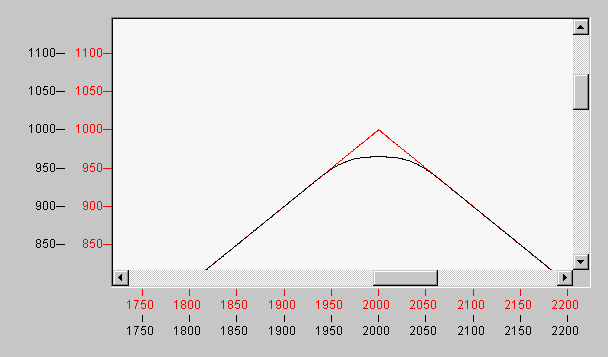Old Bezier blending type
 | Functions for compatibility with existing projects These functions are provided for compatibility reasons. For new projects Bezier curve of the 3rd order or Bezier curve of the 5th order should be used. |
Old Bezier blending with paramVertexSmoothing
|
Command |
#set paramVertexSmoothing(<type>; <subtype>; <radius> )# |
|
Parameter <type> |
For Bezier Spline smoothing: 1 |
|
Parameter <subtype> |
For Bezier Spline smoothing: 1 |
|
Parameter <radius> |
radius of the tolerance sphere |
Sample 1:
N10 R57=100
#set paramVertexSmoothing(1; 1;R57)# Old Bezier blending with paramSplineSmoothing
With the aid of smoothing, it is possible to insert a Bezier spline automatically between two geometrical entries. It is only necessary to program the radius of the tolerance sphere. This describes the maximum permissible deviation from the programmed contour in the segment transition. The advantage of this type of smoothing as opposed to rounding with an arc is that there are no step changes in acceleration at the segment transitions.
The radius of the tolerance sphere can be altered at any time within the NC program, and can be switched off again by setting the radius to 0. If the radius is not reset to 0, it remains active until the next interpreter reset or TwinCAT restart.
|
Command |
#set paramSplineSmoothing( <radius> )# |
|
Parameter <radius> |
Radius of the tolerance sphere |
or alternatively
#set paramVertexSmoothing(...)
Sample 1:
Sample 2:
The new parameter is valid from the transition between the subsequent two segments. In example 2, the new value for the tolerance sphere is applicable at the segment transition from N30 to N40. The diagram below shows a contour with and without spline at the segment transition.

The splines are generated even at very sharp angles by default. In order to avoid the dynamic values being exceeded, a considerable reduction velocity is required in this case. However, as the dynamics are held constant, the movement across the spline can be quite slow. In this case it is often practical to start the segment transition with an accurate stop. In order to avoid manual calculation of the angles, an 'AutoAccurateStop' command is available which can also be initiated via the NC program.